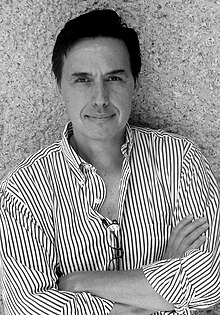Juan Fernando Bastos
| Juan Bastos | |
|---|---|
 |
|
| Born |
Juan Fernando Bastos 18 January 1958 Caracas, Venezuela |
| Nationality | American of Bolivian descent |
| Education |
Montgomery College
Maryland Institute College of Art Towson University |
| Known for | Portrait Artist |
Juan Bastos (born 18 January 1958, in Caracas, Venezuela) is an American portrait artist of Bolivian descent who also creates other representational art, including pieces that utilize mythology and symbolism. He works primarily in painting and drawing and currently resides in Los Angeles, California.
Born in Caracas, Venezuela, on 18 January 1958, to an expatriate Bolivian family, Bastos' interest in portraiture was sparked at the age of ten when he posed for a portrait by his aunt, Bolivian artist Yolanda de Aguirre. At the age of eleven, he returned to Bolivia with his family and they settled once again in La Paz where he was exposed to the vast Andean landscape and the Aymaran culture with its myths and legends, which became a major influence on his work. His formal training began at age 13 with de Aguirre, as well as artists Agnes Ovando-Sanz de Franck, Gonzalo Rodriguez, and another aunt, noted artist Maria Esther Ballivian. He was introduced to the masterpieces of the great European artists, copying the works of da Vinci, Michelangelo and Cézanne.
In 1977, Bastos enrolled at Universidad Mayor de San Andrés in La Paz where he studied architecture. He moved to Washington, D.C. in 1979, enrolling first at Georgetown University and then at Montgomery College. In 1982, he was admitted to the Maryland Institute College of Art where he continued his studies in Fine Arts graduating Cum Laude in 1984. He received his Masters of Fine Arts from Towson University in 1986.
From his home in Baltimore Bastos began his career and, in 1988, had his first solo show at gallery Arte Unico in La Paz. It featured portraits of Bolivian society figures, including Ximena Sánchez de Lozada, the wife of future Bolivian President Gonzalo Sánchez de Lozada. His first major solo exhibition in the U.S. was held in 1989 at the Knight Gomez Gallery in Baltimore. Entitled Myths & Dreams, it showcased Bastos’ emerging representational style that fused his Catholic roots with Andean mythology and symbolism. Two years later, the Inter-American Development Bank in Washington, D.C. presented Bastos’ work in a solo show, which also featured additional oils and pastels from this oeuvre. Another one-man exhibition in La Paz in 1993 showcased both traditional portraits and representational works that explored the myth of the Lake Titicaca mermaids. In 1994, Galeria Borkas in Lima, Peru, presented Milagros, Bastos’ one-man exhibition of works depicting the interplay between the Catholic and pagan belief in miracles and the South American tradition of milagros.
...
Wikipedia
